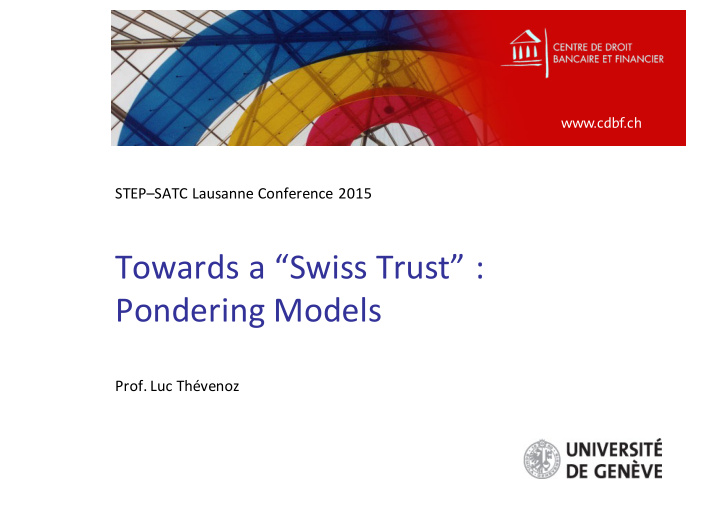



www.cdbf.ch STEP–SATC Lausanne Conference 2015 Towards a “Swiss Trust” : Pondering Models Prof. Luc Thévenoz
Swiss trust: who for? what for? Promoting a “Swiss trust” requires clear choices: n family planning or commercial transactions? n domestic or international? With a clear choice in mind, keep other options open as far as possible 2
Features n Split benefits from legal and managerial control of assets n Allow a wide range of governance arrangements n Flexibility in designing benefits , including discretionary benefits n Persistence over medium and long run n Adaptability to change of circumstances, including supervision of courts (or other?) n Insolvency -proof (“ring fencing”) n Need to co-ordinate with legal regimes protecting spouses, heirs n Need to co-ordinate with tax law 3
Features 4
Model 1 : Fiduciary contract supercharged n Swiss courts, practitioners and policymakers familiar with fiducie n Contractual foundation easily (mis-)understood n Contracts for the benefit of third parties are recognsied 5
Model 1 : Fiduciary contract supercharged ✔ ok (title vs personal claims) atypical for contracts ☕ actus contrarius or court ☕ ✔ ok needs serious changes ☕☕ ☕☕ ☕☕ ☕☕ discretionary benefits 6
Model 1: The San Marino twist Law of 1 March 2010 on affidamento fiduciario (fiduciary entrustment) n Contract between affidante and affidatario n over a programme that dedicates assets and benefits deriving from them to one or more beneficiaries n … who need not be identified at the time of the contract n affidante’s heirs don’t inherit affidante’s rights and powers, unless otherwise provided 7
Model 2: Private foundation n Congruence of patrimony and legal personality § attractive to European legal minds § triggers a special tax regime n Requires clear distinction between private and charitable foundations (fondation patrimoniale, fondation d’utilité publique) n Requires a re-thinking of family foundations in Civil Code § types of benefits § limit in time? § supervision 8
Model 2 : Private foundation ok ✔ ✔ ok courts vs public ✔ ok administration ☕ ☕ needs serious changes ok ✔ 9
Model 3: Transplanting trust into Swiss law n Reputable, fashionable, has withstood the test of time n Scotland and other civil law jurisdictions are proof that trust does not need equity in the English sense n Property or obligations? § Property and obligations § Numerus clausus doctrine 10
Model 3 : Transplanting the trust ☕ ☕ needs serious changes ok ✔ court supervision ☕ ☕ careful balancing perpetuity period ☕ ☕ discretionary benefits 11
Scorecard Contract Foundation Trust Mentally comfortable… Familiar The international standard as “false friends” often are International standard Allows broader uses than foundation Strong risk of over- Requires reconsidering stretching some traditional ideas Challenges deep dogmas of civil law Does not challenge More specialised than current tax treatment the other two Would also require overhaul of existing tax Might be politically more Already enjoys its own treatment palatable tax regime ➊ 12
Outlook n No real “low hanging fruits” n We need to be honest on what we want to achieve and open on choosing the basic design n Tax fairness is key selling point n Acknowledge need to maintain protection of creditors, spouses and heirs n Use traditional recipes § e.g., major disposition inter vivos with long term effects may be well served by notarisation n Consider arbitration as alternatives to courts 13
Further references available on www.cdbf.ch/steplausanne/ n Luxembourg § Projet de loi relative à la fondation patrimoniale (2013) n San Marino: § Legge del 1 ° Marzo 2010 – L’istituto del’affidamento fiduciario § English translation by M. Monte and P. Mathews n Switzerland § Projet de codification de la fiducie (Thévenoz, 2001) 14
Recommend
More recommend